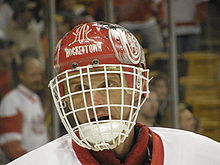Goalkeeper mask
The goalkeeper mask is part of the protective equipment in ice hockey , hockey and related sports, which serves to protect the face of the respective goalkeeper .
history

Clint Benedict became the first ice hockey goalkeeper to wear a mask when he protected his nose, which he had recently broken, in the 1920s. After the injury had healed, however, he took off the mask - and shortly afterwards broke his nose again, which ended his career. It wasn't until the late 1950s that goalkeepers in the National Hockey League began wearing face shields in every game. Jacques Plante led the way after being hit in the face by a puck. He wore one made of fiberglass-reinforced plastic(GfK) made mask, which was adapted to his face and fastened behind the head with leather straps or rubber bands. However, it only protected the face, the rest of the head remained unprotected. This model became the standard for goalkeepers, allowing them to accept fewer goals as they got on their knees much more often to block shots without risking dangerous head and face injuries. Gump Worsley was the last goalkeeper to win the Stanley Cup without a mask in 1969 . After he and Joe Daley had also opted for a mask in the 1973/74 season , Andy Brown of the Pittsburgh Penguins remained as the last goalkeeper without a mask in the NHL. Brown then moved to the World Hockey Association and played there until his retirement after the 1976/77 season without face protection.
In the 1970s, the goalie mask developed further, which thanks to its larger surface protected almost the entire head and thus allowed even fewer injuries.
At that time, a new era of the goalkeeper mask had already begun. More and more goalies were wearing a combination of a simple field player's ice hockey helmet and grille protection. This now unusual version was last worn in the NHL until 2008 and 2011 by Detroit goalkeepers Dominik Hašek and Chris Osgood . The problem with these models is that they cannot dissipate the force of a hard slap shot very well, but with this type of head protection the goalkeepers have a larger field of vision.
In the mid-eighties, goalkeepers went back to the GfK masks, as they were already worn by Ken Dryden and Bernie Parent in the 1970s, as they better protected the goalkeeper from heavy impacts. The most important change, however, was that there were no separate openings for each eye or breathing holes, but an opening that reached from the eyebrows to the mouth and was closed by a grid. This model established itself and is still the mask worn by most goalkeepers today. The model consists of the mask itself, which protects the face, the top of the skull and the side of the head, and a separate plate, which protects the back of the head and is attached to the mask with elastic bands. Even today, goalie masks are made of plastic reinforced with glass fibers, but some models are also made with carbon fibers or a combination of aramid and glass fibers.
Both the modern GRP masks and the helmet / grille protection combination are also used in hockey , inline skater hockey , inline hockey , floorball , roller hockey and other types of hockey .
In an accident on March 22, 1989, the unprotected neck of the former goalkeeper Clint Malarchuk was hit by a skate blade. The cut went so deep it almost bled to death. This prompted many goalies to wear neck protectors in addition to the goalkeeper's mask. Since then, they have been mandatory in many leagues. Many newer models have a bracket for neck braces or have an elongated shape.
design
With the introduction of goalkeeper masks, goalkeepers began to use the surfaces of the masks for painting. Mainly the normally white masks were painted in the team colors. Gerry Cheevers became famous for painting scars on his mask. These painted scars should show where he would have sustained injuries all over his face had he not worn the mask.
Today almost every professional ice hockey goalkeeper wears his own individually designed mask, the elaborate design of which is often based on the team and its colors. But personal preferences can also be found on them. The Czech goalkeeper Roman Turek, as a fan of the heavy metal band Iron Maiden , immortalized Eddie , the band's mascot, on every mask . With Martin Brodeur are on the back of the head plate of the mask, the first letter of the name of his four children and on the mask of Jaroslav Halák 's goalkeeping legend Patrick Roy to see the how Halák his first steps in professional ice hockey with the Montreal Canadiens made. Boxing fan Ray Emery ran into problems with his design in 2006 when he was active for the Ottawa Senators after he had the American boxer Mike Tyson painted on his mask. Management spoke out against the design over Tyson's criminal career, and Emery had Canadian boxer George Chuvalo painted on his mask.


